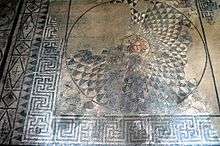Marcianopolis
| Μαρκιανούπολις | |
 Shown within Bulgaria | |
| Location | Bulgaria |
|---|---|
| Region | Varna Province |
| Coordinates | 43°13′30″N 27°35′06″E / 43.225°N 27.585°E |
Marcianopolis or Marcianople (Greek: Μαρκιανούπολις) was an ancient Roman city in Thracia. It is located at the site of modern-day Devnya, Bulgaria.
History

Roman Emperor Trajan renamed the ancient city of Parthenopolis after the Second Dacian War, which ended in 106. The city was renamed after Trajan's sister, Ulpia Marciana.[1] An important strategic centre, the city was part of Roman Thrace until 187–193, and then belonged to Moesia inferior. Marcianopolis's prosperity under the Severan Dynasty was ended by a Gothic raid in 248–249 and subsequent barbarian invasions from the north. The Romans repulsed another Gothic attack to this town in 267 (or 268), during the reign of Gallienus.[2]
Under Emperor Diocletian Marcianopolis became the centre of the province Moesia Secunda of the Diocese of Thrace, and was rebuilt thoroughly in the late 3rd and early 4th century. It grew in importance at the expense of neighbouring Odessos (Varna) in the 4th century. The city was an important episcopal centre and a basilica from the period was excavated in the 20th century. During Emperor Valens' conflict with the Goths (366–369), Marcianopolis was a temporary capital of the empire and the largest city of Thrace according to a source from the period.[3]
In 447, it was destroyed by the Huns under Attila, immediately after the bloody battle of the Utus river.[4]
Emperor Justinian I restored and fortified it. In 587, it was sacked by the king of the Avars but at once retaken by the Byzantines.[5] The Byzantine army quartered there in 596 before crossing the Danube to assault the Avars.[6] Despite the regular barbarian attacks, Marcianopolis remained an important centre until an Avar raid finally destroyed it in 614–615, although it still continued to be mentioned on maps until much later.
As the Slavs settled in the Balkans in the 7th century, they called the ruins of the ancient city Devina. At present, remains of the Roman city include the amphitheatre and many exquisite mosaics. The Museum of Mosaics in Devnya features some mosaics in situ.[7]
References
- ↑ Ammianus Marcellinus, XXVII, 4, 12
- ↑ Historia Augusta, Claudius, 9; Zosimus, I, 42
- ↑ Amm. Marcell., XXVII, 5; Theophanes the Confessor Chronographia, A. M. 5859, 5860, 5861
- ↑ Thompson, E. A.; Heather, Peter. The Huns, Blackwell, 1999. pp. 101–102. ISBN 0-631-21443-7.
- ↑ Theophanes the Confessor, "Chronographia" A. M. 6079
- ↑ Theophanes the Confessor, "Chronographia", A. M. 6088
- ↑ http://liternet.bg/publish10/aangelov/mozaikite.htm
External links
Coordinates: 43°13′30″N 27°35′6″E / 43.22500°N 27.58500°E
closed